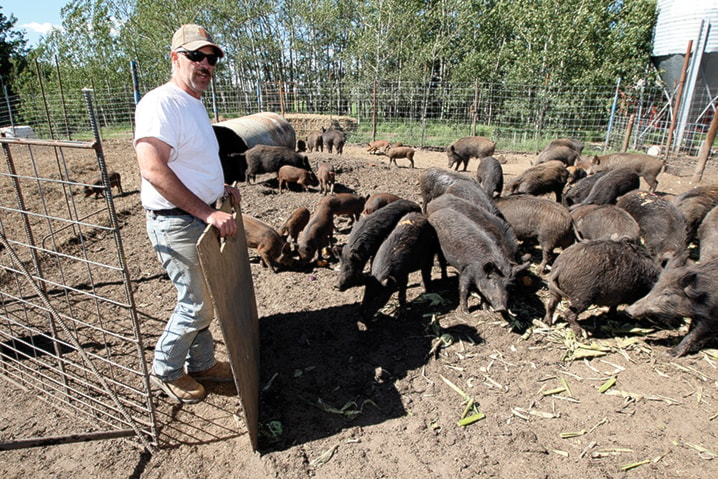Behind doubled-up fencing, electric wire and a sturdy padlocked gate dozens of grunting, snuffling wild boar are oblivious to the controversy surrounding them.
Ray McKinnon has a sow, boar and more than 50 piglets and yearlings in an enclosure on his Penhold-area property. He is breeding them for hunts and believes, if handled properly, Red Deer County need not worry about escapes — a problem that other municipalities have faced.
Council voted earlier this month to enter into an agreement with Alberta Agriculture and Forestry, which enforces wild boar regulations.
Once the agreement is signed, the county intends to create a bylaw prohibiting wild boar farms. Council is concerned that wild boar could escape and the elusive creatures could proliferate.
McKinnon doesn’t deny that escaped boar have proven a problem in some rural areas in the past. But the Alberta government has since adopted regulations to ensure that wild boar enclosures are properly secured and the facilities are inspected.
At his pen, McKinnon has exceeded the regulations. His posts and fence are deeper into the ground than required, posts are closer together, electric wiring strength higher and fencing doubled up. The enclosure is inspected twice a day to ensure it’s secure.
If he needs to go into a pen, he must remove a padlock and another person armed with a rifle stands guard in case one of his Russian Razorbacks makes a dash for it.
“They get out, they get shot. That’s all there is to it.
“(Escapes) cannot happen.”
The boar are not the wild animals that some believe, he said.
“These guys have been raised in captivity. They are not really a wild hog. They’re not feral.”
Despite assurances from wild boar supporters, past experience with escapees worries provincial and municipal officials. First imported into the province for hunting in the early 1990s, enough boar escaped and bred to create a significant nuisance in some rural areas, particularly Lac St. Anne County northwest of Edmonton.
In Alberta, hundreds of wild boar have been killed for a $50 bounty since they were declared a pest by the province in 2008.
Saskatchewan also has a big problem with wild boars, which were described by one agricultural scientist as an “ecological train wreck.”
Red Deer County had its own small problem with boars around that time in the southwest corner of the county. Eventually, 19 boars were killed.
Mayor Jim Wood said no matter how good the enclosure, the county is worried escapes could happen.
“A fence is only as good as a gate that’s left open” he said.
If a male and female get out, the prodigious breeders could create a population in the thousands in just a few years.
On top of that, a large boar can be ferocious opponents for any human and won’t give up until a person is down.
“If they can do that to a man, what will they do to a child?”
Besides the danger, the boar love to root around and could cause considerable damage to gardens and crops.
On top of that, the boar are only around for one purpose — to hunt, says Wood. There is plenty of regular pork available for eating without adding wild boar to the menu.
Wood said he hasn’t heard from any farmers who are in favour of wild boar operations in the county.
It boils down to learning from other’s experiences, he said.
“We have to take a look at what has happened in other jurisdictions around North America that have had these animals get away and how much trouble they’ve had to control them. Have they even been able to control them?”
He compares wild boar to weeds.
“Once they start to multiply it’s hard to control. It’s far easier to control before you have the problem.”
In Mountain View County, the discovery of an unlicensed boar hunting operation had staff and council scrambling in response. County officials inspected the operation and ensured it was secure. However, the prospect of others opening up was not palatable to council.
On June 8, council voted to amend the county’s Animal Control Bylaw to make wild boars a prohibited animal, even in an agricultural operation, effectively banning them.
County Reeve Bruce Beattie said the municipality already had experience a number of years ago with feral boars that escaped a now-defunct breeding facility. Before long, 30 or 40 boar were roaming around. The county put a bounty on them and hunters managed to kill them all over the next six months or so.
Rather than risk more escapes, council decided to impose a blanket ban.
“We’re just trying to nip it in the bud and prevent future problems.”
There currently aren’t any hunting facilities in Central Alberta. One in Clearwater County closed down when the property was sold.
McKinnon said they are hoping to find another piece of land that can be fenced and boars let loose to be hunted. That will give Central Alberta boar hunters a place to go and a spot to host charitable Wounded Warrior events, where Canadian veterans are invited to hunt for free.
